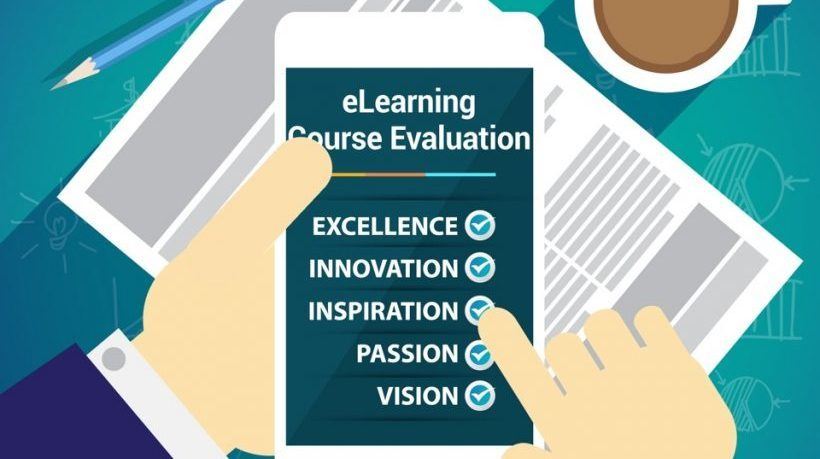All eLearning Pros Need To Know About eLearning Course Evaluation
eLearning professionals put a lot time, effort, and dedication into the eLearning course design process. So, we may be a bit biased when it's time to evaluate our handiwork. In fact, finding the faults and figuring out how to move past them can be one of the biggest challenges. But there are some simple and inexpensive ways to evaluate your eLearning course. This gives you the power to fine tune your eLearning course design and provide the best possible eLearning experience. In this article, you'll discover how to evaluate your eLearning course and what to do with the eLearning course evaluation data you've collected.
5 Ways To Evaluate Your eLearning Course
1. Know Your Learning Objectives Before Making Inquiries
All of your eLearning course evaluation efforts rely on one very important thing: the desired learning outcome. So, before you start asking questions, you have to know WHY you’re evaluating your eLearning course in the first place. Clearly identify your learning objectives and goals beforehand so that can create targeted inquiries that result in valuable feedback. Bear in mind that your online learners only have a limited amount of time to answer your questions. Thus, you have to narrow your list to a chosen few, preferably those that address your main concerns.
2. Create Interactive Online Surveys And Questionnaires
Feedback forms don't have to be dull. In fact, you can create interactive online surveys and questionnaires that are actually entertaining. Online learners are taking time out of their schedules to complete the online survey. As such, you should make it as enjoyable and stress-free as possible. Add drag and drop interactions, multimedia, and memorable eLearning characters to your online surveys. You can even transform it into a simulation or serious game that immerses them in an adventure.
3. Host Q&A Webinars
Webinars are a great eLearning tool, but they also give you the chance to receive valuable feedback. Host a monthly Q&A session where online learners can make inquiries and address their concerns. Likewise, you have the opportunity to ask them pressing questions about your eLearning course design and their overall eLearning experience. However, the questions they ask you typically provide greater insight. As an example, if a good percentage of your audience asks about a specific eLearning activity, this automatically puts the spotlight on that online exercise and prompts you to take a closer look. Just be sure to give them a list of topics beforehand so they can brainstorm relevant questions or responses.
4. Be Aware Of eLearning Course Evaluation Limitations
You want to learn as much as you can about the learner experience so that you can improve your eLearning course design. However, there are certain things that are out of your online learner's scope. For example, they probably aren't familiar with Instructional Design models or theories. Thus, you may want to steer clear of "behind the scenes" questions that don't pertain to the end-user eLearning experience. If your online learners are hesitant to participate in online surveys or questionnaires, consider making them anonymous so that they are free to speak their minds.
5. Take A Look At Your LMS Analytics
One of the most overlooked forms of eLearning course feedback is your LMS analytics. Many Learning Management Systems feature reports that allow you to track every aspect of your eLearning course. This includes online learner performance, progress, and completion rates. For example, if a majority of your online learners are unable to finish an eLearning activity, this may indicate that the difficulty level is too high. Likewise, if online learners are breezing through an eLearning course in record times, it may be time to make it more challenging.
4 Ways To Use Your eLearning Course Evaluation Data
1. Ask Follow Up Questions
In some instances, you may not have all the data you need to take action. This is when follow up questions are in order. Take your eLearning course evaluations a step further by hosting focus groups, eLearning forums, and interviews. This allows you to clarify some of the trends or patterns you found within your "big data". Thus, you have the ability to focus your attention on the issues that matter most.
2. Offer Supplemental eLearning Modules To Fill The Gaps
Supplemental online resources are a cost effective alternative to reworking your entire eLearning course design. You can provide additional information or real world experience by incorporating links to eLearning articles, online activities, and modules. These tools help to fill the gaps and allow online learners to explore the topic on their own. For example, an online learner who finishes the eLearning course quickly and wants to know more can access optional eLearning videos and infographics.
3. Examine Each Element Of Your eLearning Course Design
There are times when your eLearning course evaluations reveal shortcomings with your eLearning course, but are unable to pinpoint the exact cause. This means it's time to break your eLearning course into its most basic components and analyze each section. For example, take a closer look at each eLearning module or activity. In depth analysis gives you the power to evaluate each piece of the puzzle instead of the big picture. You can also create follow up online surveys for specific sections to identify areas for improvement.
4. Set Up An eLearning Course Evaluation Schedule
eLearning course evaluation is an ongoing process. After making the necessary changes and adjusting your eLearning strategy, reevaluate your eLearning course to verify that the problems have been addressed. If all is well, schedule another eLearning course evaluation session annually, or even quarterly, to stay on track. By doing so, you keep up with your online learners' needs and ensure that your eLearning course is living up to your expectations. You can also integrate new instructional design strategies or technologies after each eLearning course evaluation so that you can keep your eLearning course fresh and modern.
One of the most stressful things about evaluating your eLearning course is dealing with differing opinions. Every online learner has their own thoughts and viewpoints about your eLearning course. Thus, you must sift through all the data to identify trends and patterns. So, plan ahead and give yourself plenty of time to evaluate all aspects of your eLearning course design.
Are you looking for additional ways to evaluate your eLearning course? Read the article 4 eLearning Course Evaluation Strategies To Receive Valuable Feedback to be able to know exactly what is right or wrong with your eLearning course.








